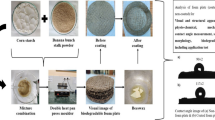Abstract
This paper presents a scheme for fractionation of liquid pyrolysis products of birch sawdust to obtain a carbohydrate fraction and its use as a biopolyol in the production of polyurethane foam. GCMS analysis and IR spectrometry of biopolyols were carried out. Samples of polyurethane foam with particular replacement of 20, 30, and 40% biopolyol were obtained. Thermal conductivity of the obtained polyurethane foam samples was measured. The results of the work carried out allow it to be concluded that reactive OH groups are present in the carbohydrate fraction and the biopolyols from pyrolysis liquid of birch sawdust can be used in the synthesis of hard polyurethane foams.




Similar content being viewed by others
REFERENCES
A. I. Sabirzyanova, A. R. Valeeva, G. M. Bikbulatova, and R. M. Khaziakhmedov, “Destruction of polyurethane foam modified with biopolyols under artificial climatic factors,” in Proceedings of the XI Internaitonal Youth Scientific Conf. “Youth and 21st Century” (Kursk, 2021), Vol. 5, pp. 382–385.
K. Błażek and J. Datta, “Renewable natural resources as green alternative substrates to obtain bio-based non-isocyanate polyurethanes-review,” Crit. Rev. Environ. Sci. Technol. 49 (3), 173–211 (2019). https://doi.org/10.1080/10643389.2018.1537741
M. Kurańska and E. Malewska, “Waste cooking oil as starting resource to produce bio-polyol–analysis of transesteryfication process using gel permeation chromatography,” Ind. Crops Prod. 162, 113294 (2021). https://doi.org/10.1016/j.indcrop.2021.113294
A. E. Yakovleva, A. I. Sabirzyanova, S. A. Zabelkin, A. N. Grachev, V. N. Bashkirov, and T. Shul’tske, “Synthesis of polyurethane foam from various types of pyrolysis liquid and analysis of its strength and chemical structure,” Derevoobrab. Prom-st., No. 4, 39–47 (2018).
J. Paciorec-Sadowska, M. Borowicz, et al., “New bio-polyol based on white mustard seed (Sinapis alba) as an alternative raw material for the polyurethane industry,” Polimery 63 (10), 694–699 (2021).
J. Kang, W. Chen, Y. Yao, et al., “Optimization of bio-polyol production from cassava residue using ethylene glycol as the liquefaction reagent,” J. Wuhan Univ. Technol., Mater. Sci. Ed. 34, 945–949 (2019).
M. A. Salleh, I. B. M. Jais, D. Che Lat, and N. Samat, “Compressibility of palm kernel oil-based polyurethane foam using rowe cell apparatus for ground improvement,” Key Eng. Mater. 844, 24–31 (2020).
https://energolesprom.ru/.
M. A. Varfolomeev, V. N. Emel’yanenko, T. R. Musin, A. V. Gerasimov, D. K. Nurgaliev, A. N. Grachev, A. A. Makarov, and S. A. Zabelkin, “Thermal analysis and calorimetric study of the combustion of hydrolytic wood lignin and products of its pyrolysis,” Chem. Technol. Fuels Oils 51 (1), 140–145 (2015).
G. M. Fayzrakhmanova, S. A. Zabelkin, A. N. Grachev, and V. N. Bashkirov, “A study of the properties of a composite asphalt binder using liquid products of wood fast pyrolysis,” Polym. Sci., Ser. D 9, 181–184 (2016).
S. A. Zabelkin, A. N. Grachev, G. M. Bikbulatova, A. E. Yakovleva, A. A. Makarov, and V. N. Bashkirov, “Resole-type phenol–formaldehyde resin with neutralized liquid products of fast pyrolysis of birch wood,” Polym. Sci., Ser. D 11, 131–134 (2018).
W. Zhang, Y. Ma, C. Wang, et al., “Preparation and properties of lignin–phenol–formaldehyde resins based on different biorefinery residues of agricultural biomass,” Ind. Crops Prod. 43, 326–333 (2013).
S. Zabelkin, A. Grachev, G. Fayzrakhmanova, A. Makarov, and V. Bashkirov, “Application of the water-insoluble pyrolysis oil fraction as an organic binder,” Constr. Build. Mater. 102, 59–64 (2016).
M. Yu. Mikulintseva, “Liquid products of wood pyrolysis as new opportunities for green chemistry,” Mezhdunar. Stud. Nauchn. Vestn., No. 5, (2018).
J. Paciorek-Sadowska, M. Borowicz, et al., “New bio-polyol based on white mustard seed (Sinapis alba) as an alternative raw material for the polyurethane industry,” Polimery 63 (10), 694–699 (2021).
S. Zabelkin, A. Valeva, A. Sabirzyanova, A. Grachev, and V. Bashkirov, “Neytrals influence on the water resistance coefficient of phenol-formaldehyde resin modified by wood pyrolysis liquid products,” Biomass Conv. Bioref., (2020). https://doi.org/10.1007/s13399-020-01025-0
A. Stücker, F. Schütt, et al., “Lignins from enzymatic hydrolysis and alkaline extraction of steam refined poplar wood: utilization in lignin-phenol-formaldehyde resins,” Ind. Crops Prod. 85, 300–308 (2016).
W. Zhang, Y. Ma, C. Wang, et al., “Preparation and properties of lignin–phenol–formaldehyde resins based on different biorefinery residues of agricultural biomass,” Ind. Crops Prod. 43, 326–333 (2013).
E. Pretsch, P. Bühlmann, and C. Affolter, Structure Determination of Organic Compounds: Tables of Spectral Data (Springer, Berlin, 2000; BINOM. Laboratoriya Znanii, Moscow, 2006).
GOST (State Standard) 7076–99: Building Materials and Products. Method of Determination of Steady-State Thermal Conductivity and Thermal Resistance (Standartinform, Moscow, 2000) [in Russian].
Author information
Authors and Affiliations
Corresponding author
Additional information
Translated by K. Gumerov
Rights and permissions
About this article
Cite this article
Valiullina, A.I., Grachev, A.N., Valeeva, A.R. et al. The Use of Biopolyols Obtained from Liquid Birch Sawdust Pyrolysis Products as a Renewable Component in the Production of Rigid Polyurethane Foams. Polym. Sci. Ser. D 15, 300–305 (2022). https://doi.org/10.1134/S1995421222020307
Received:
Revised:
Accepted:
Published:
Issue Date:
DOI: https://doi.org/10.1134/S1995421222020307




